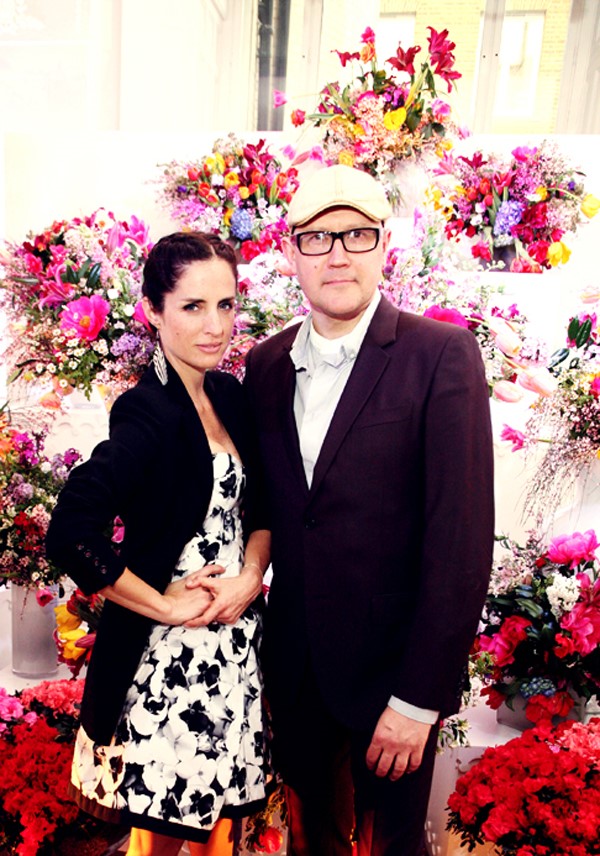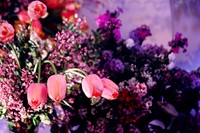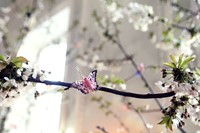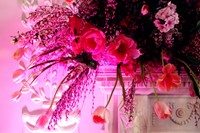What better way to launch a flower inspired fragrance than to host a 'flower madness' event complete with floral themed interior, food and drinks?
What better way to launch a flower inspired fragrance than to host a 'flower madness' event complete with floral themed interior, food and drinks? To celebrate the launch of her new fragrance CH L’eau, Carolina Herrera, daughter of fashion designer Caroline Herrera and head of fragrances, partnered with set design extraordinaire Simon Costin, transforming 29 Portland Place, a Grade II listed Georgian mid-terrace, last night into a flower extravaganza. Waitresses in traditional maid's outfits served afternoon tea, whilst floral vintage dressed models transformed the surrounding empty room into an incredible pyramid stage of bouquets. Later on guests were greeted with lavender and rose petal cocktails upstairs for Carolina's party hosted by AnOther. Here blossom trees exploded out of window boxes, with dragonflies and butterflies – emblems of the perfume – sitting atop the Victorian furniture and across the high-ceilinged walls.
AnOther took time out to discuss the flower collaboration between creative director Carolina Herrera and Simon Costin, who has previously worked with Alexander McQueen, Givenchy, Tim Walker and Nick Knight.
So what were your inspirations behind this event?
Carolina Herrera: Flower madness. The whole idea of flower madness – an excess of flowers, an element of eccentricity, a twist and a sense of humour. I am also a great lover of flowers and have been since I was young. My mother [Carolina Herrera senior], had a garden with flowers and my dad was the gardener – he was always cutting them, and she arranging them. Before she had a perfume, before she was even a designer, known, anything, she used to mix oils, tuberose oils with gardenia and jasmine, which she used to buy from Bloomingdales. So flowers are something that’s always been around my family.
And for you Simon, what do flowers mean to you – they’ve been a focus of much your work and set designs in the past but how important are flowers to you?
Simon Costin: Well, my favourite flower is the dog rose: it’s wild and completely transforms a country lane rather than a cultivated flower. I have also always liked tulips because of the bizarre history that tulips have had through the 18th and 17th century, and therefore when thinking up this flower madness they were the perfect choice for the bouquets that blanket the interior of Portland Place. When I work with flowers, with people like Tim Walker, we’re always doing giant flowers or walls covered in flowers – they feature quite a lot throughout my work.
CH: And actually with the shoot, the advertising Tim Walker did for the last perfume, at the edge there was cherry blossom. Flowers are very important.
What do you want the viewers to get from the experience?
SC: A sense of abundance, of richness, with that hint of scent but focusing obviously on the beautiful perfume. So my creation acted as a backdrop to all of that with an element of craziness and over-the-top.
How long did it take to put together?
SC: The actual presentation of the perfume went through quite a lot of changes, mutations. There were ideas to do giant pop-up books, and small pop-up books, and then the flower pyramid came together as a formative idea so that it would act as a backdrop for the speeches. So rather than just listening to someone walking around talking, there would be a performance going on in the background, giving another level of meaning to what they’re talking about.
There’s a beautiful attention to detail – do you find that very important in what both of you do?
CH: For me, it’s the most important. I pay such super, such minute attention to detail that sometimes I think I’m the only one who sees the detail and it goes to waste. But I do that with everything whether it’s my child’s birthday party or an invitation that I’m writing. So it’s something that I just do naturally. And it makes it more fun.
SC: And also I think it’s a very good indicator of creativity. If you’re that fixated, which we are, which I think is healthy, some people might not think that…
CH: My husband thinks it’s more unhealthy.
SC: I think those degrees of obsessiveness is what will make something special in the end. If it’s a bit slapdash, and “well, yeah, it looks okay”, I can see that a mile off. So all that attention to detail, that anal attention to detail, it’s really exciting. And quite sexy.CH: And it makes it more interesting, it makes it more fun, that you’re fixating on whether the girl’s little hats has two flowers or three, and in what direction do they go. I mean, it may be meaningless, but it’s not. And in the end all of them will make a statement.
Finally, if you could sum this whole event and experience up in a piece of music, what would that be?
CH: In a piece of music…That’s a good question.
SC: I would say something by the composer Joseph-Maurice Ravel – there’s a piece of Ravel that starts off quite low-key and then builds and builds and builds and builds and gradually becomes more florid, and richer and deeper and crazy towards the end.
CH: Something crazy and unsymmetrical… I wish I was musical, but I’m not. I’ve got the worst ear. Thankfully a good eye and sense of smell though.
Text by Lucia Davies



